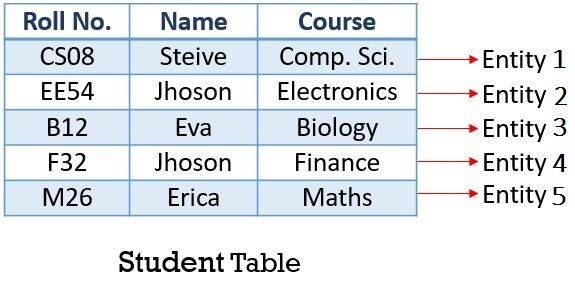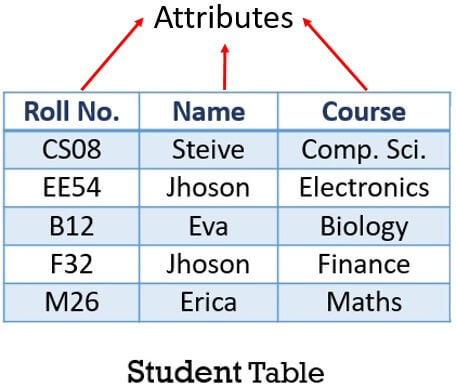Entity and attribute are the most common terms of DBMS. The fundamental difference between the entity and attribute is that an entity is an object that exists in a real-world and can be easily distinguished among all other objects of real-world whereas, the attributes define the characteristics or the properties of an entity on the basis of which it is easily distinguishable among other entities of the real-world.
In the relational database, we collect the data in the form of a table. So, the rows of a table represent the entities of the same type and the columns of a table are considered as attributes of the entities present in that table. In this section, we will discuss some more differences between an entity and attribute with the help of a comparison chart. We will also discuss entity and attribute in brief.
Content: Entity Vs Attribute
Difference Chart
| Basis of Differentiation | Entity | Attribute |
|---|---|---|
| Basic | An entity is a distinguishable real-world object that exist. | An attribute describes the elementary feature of an entity. |
| Relational Data Model | In the relational data model, an entity is represented as a record in an entity set. | In the relational data model, a field represents an attribute. |
| Table | A row in a database table is an entity. | A column header of a database table is an attribute. |
| Grouping | Entities of similar type are placed in one entity set/table. | Group of attributes that easily identifies a tuple forms a key. |
| Refinement | An entity can be a tangible entity or an intangible entity. | Each attribute has a certain domain and it may be involved in forming a key. |
| Example | A student tuple in a student table in the database represents an entity. | Name, roll number, Id, Address, these fields of student table presents the attribute of student entity. |
What is Entity in Database?
An entity is a distinguishable real-world ‘object’ that exists. An object should not be considered as an ‘entity’ until it can be easily identified from all other objects of the real world. In a database, only that ‘thing’ or ‘object’ is considered as an entity about which data can be stored or retrieved. As if you are not able to store data about some object or if you are not going to retrieve data about some object then there is no point in creating that entity in a database.
The entities sharing the same set of properties or same set of attributes are kept in one entity set which is also known as a relation or a table in the relational database. An entity in an entity set is represented by the sequence of attributes values which is simply a sequence of values hence, it is also called as a tuple.
In the relational model, each entity sets are represented by a table. So, each row of a table in the database represents an entity. It is essential that a table must not contain duplicate entities as it will lead to ambiguity. Each entity in a table must be uniquely identified which means two entities in a relation, should not contain the same set of values for the same set of attributes. An entity can be anything that exists in real-world like it can be a person, thing, place, object, event, etc.
An entity is further classified into two types, i.e. tangible entity and intangible entity:
- A tangible entity is one which physically exists in real-world. Such as a person, student, bank locker, etc. are examples of tangible entities, we can touch them as they physically exist.
- An intangible entity is one which exists logically in real-world such as bank account, reservation, email account etc. Like a tangible entity, we can easily identify the intangible entity such as a bank account has an account no. using which we can easily identify that bank account, but we cannot touch it, as it doesn’t exist physically in the real world.
The figure below shows the entities in the student table:

As you can see in the figure above we have five entities in the student table. Though we have two students with the same name ‘Jhoson’ we can easily distinguish among them because they have a distinct roll number. So, we conclude that the entities are the real-world objects that are easily distinguishable.
What is Attribute in DBMS?
Attributes describe the characteristics or properties of an entity in a database table. An entity in a database table is defined with the ‘fixed’ set of attributes. For example, if we have to define a student entity then we can define it with the set of attributes like roll number, name, course. The attribute values, of each student entity, will define its characteristics in the table.
In a relational database, we store data in the form of tables. The column header of the table represents the attributes. A table must not have duplicate attributes. Each attribute in a table has a certain domain which allows it to accept a certain ‘set of values’ only. In an entity, each attribute is allowed to have only one value which could be a number, text, date, time etc. (defined in SQL standard).
Attributes have further refinement such as keys. A single attribute or a set of attributes that can distinguish an entity in an entity set/relation is termed as key. In the database, we have a primary key, super key, composite key, foreign key. All of them are created with a certain purpose to normalize a relation in the database.
Observe the figure below it shows the attributes of the student table:

As you can see in a student table we have three attributes Roll No., Name and Course. The attribute values of each student entity define its characteristics in the table, which in turn help us to identify each student entity in the student table uniquely.
Key Differences Between Entity and Attribute
- The basic difference between entity and attribute is that an entity is a distinguishable real-world object that exists, whereas attribute describes the elementary features of an entity.
- In the relational database model entities are termed as record and attributes are termed as fields.
- In the relational database model, we store data in the tables. So, the rows of table denote the entities and the column header of the table denotes attributes of an entities in a table.
- An entity can either be a tangible entity or an intangible entity. On the other hand, the refinement of attributes includes the domain of attribute and key attributes.
- The entities sharing the same elementary properties (attributes) are grouped in one entity set. The set of attributes that can distinguish an entity in a table is grouped to form a key.
- The entire information of a single student in a student table represents an entity. The name, roll no, course parameters that form the complete information of a student are attributes of the student entity.
Summary
So, the object that exists in the real world can become an entity only when it is easily identified among other objects of the real-world. And the characteristics that allow an entity to get identified easily are called attributes. Entities in a database are identified on the basis of values its attributes possess.

Jerry Musah says
Am impressed with what am seeing here and is very helpful
Kemmy says
Simple and clear explanations. Thank you.
Jeffrey Maku KEPOLI says
Very helpful with easy to understand notes and explanations.